전시
-
2021년 아르코미술관 기획초대전《정재철: 사랑과 평화》
- 전시기간
- 2021.07.01~2021.08.29
- 관람료
- 무료
- 오프닝
- 장소
- 아르코미술관 제1,2전시실
- 작가
- 정재철(1959–2020)
- 부대행사
- 주관
- 아르코미술관
- 주최
- 한국문화예술위원회
- 문의
- 02-760-4607
첨부파일
2021년 아르코미술관 기획초대전《정재철: 사랑과 평화》
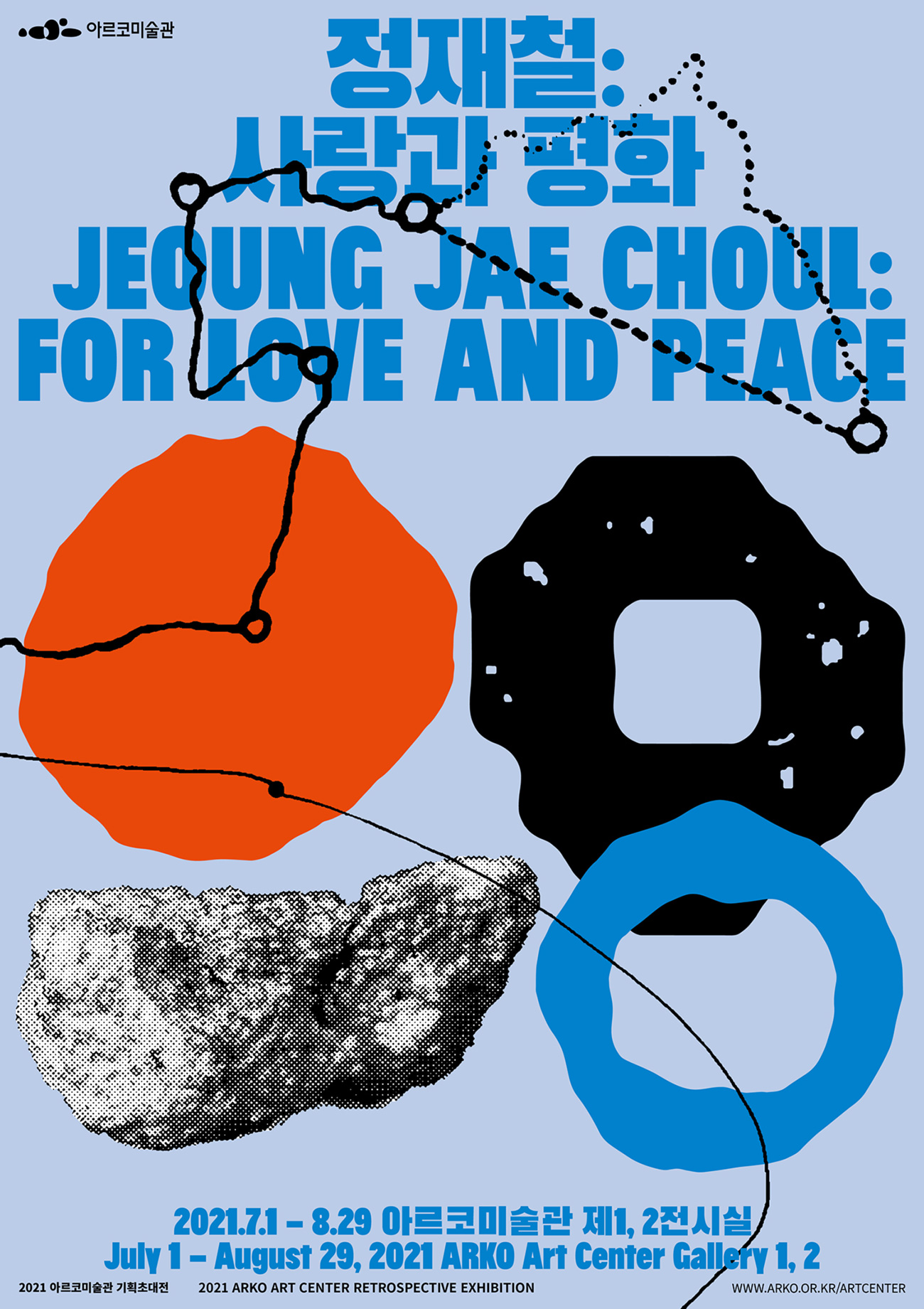
전시관람 온라인 사전예약 : https://booking.naver.com/booking/12/bizes/544990
전시해설 온라인 링크 : https://www.youtube.com/watch?v=tQEPxlon_8o
※ 사전신청은 선착순 예약제로 운영되며, 사전신청 가능인원은 1명당 2명까지 신청가능합니다.
※ 사전신청 후 방문이 어려울시 방문일 하루 전까지 사전취소 부탁드립니다.
※ 온라인 사전예약 접수를 우선으로 하며, 온라인 사전예약 미달 및 취소 시 해당 인원수에 한정하여 현장 접수가 가능합니다.
▣ 전시개요
- 제목 :《정재철: 사랑과 평화》
- 전시일시 : 2021년 7월 1일(목) – 8월 29일(일)
- 전시장소 : 아르코미술관 제1,2전시실
- 관람료 : 무료
- 작가 : 정재철(1959–2020)
- 참여자 : 백종관(커미션 영상작품), 이아영(작가노트 연구·편집)
- 주관 : 아르코미술관
- 주최 : 한국문화예술위원회
- 운영시간: 화-일요일, 오전 11시-오후 7시
*단체 관람 및 전시 해설 서비스는 진행하지 않으며, 아르코미술관 온라인 전시 영상으로 이를 대체합니다.
▣ 전시소개
2021년 아르코미술관 기획초대전은 작가 정재철(1959 – 2020)의 작고 1주기전으로 마련한다. 《정재철: 사랑과 평화》전은 장소를 이동하며 수행했던 참여 형식의 프로젝트를 살펴보며, 현장작업의 결과물로 ‘기록과 수집’된 작업을 재구성하여 작가가 지향했던 예술적 실천을 따라가 본다.
정재철은 1988년 중앙미술대전에서 대상을 수상한 이후 조각매체를 다루는 작가로 주목받기 시작하였다. 이후 1995년 당시 출강하던 대학교에서의 뒤셀도르프 쿤스트 아카데미 교류 워크숍의 계기를 통해 해외 레지던시에 참여했으며, 이는 작가의 미술언어를 성찰하는 결정적 시기였다. 작가는 한국 미술계가 겪은 세계화라는 변화 동력과 함께 2000년대부터 여행과 이동을 통한 개념적이고 수행중심의 미술언어로의 전환을 모색했다.
이번 전시는 2000년 이후를 작업에 대한 태도와 방법론적인 변화의 전환점으로 보고, 현장 작업 〈실크로드 프로젝트〉(2004 – 2011), 〈블루오션 프로젝트〉(2013 – 2020)를 통해 작가 정재철의 태도와 사유의 변천, 사회적인 문제를 향한 작가의 성찰을 보여준다.
제1전시실은 사진, 영상, 루트맵, 여행일지 등 기록매체를 중심으로 〈실크로드 프로젝트〉(2004 – 2011)를 재맥락화한다. 정재철에게 여행이라는 이동과 길 떠남은 곧 삶의 방식과 예술적 실천이었다. 근대 이전에 유라시아를 관통하는 교역 경로였던 실크로드를 따라 실크로드 프로젝트를 실행했던 정재철은 국가의 경계를 넘으며, 길 위에서 폐현수막을 나누어주고 뜨거운 태양 아래 그늘을 만들었다. 그리고 우연한 만남, 교류, 사건과 상황을 만들고 기록하였다. 이렇게 걷기라는 반복된 순간들로 이루어진 경로들은 루트맵이라는 지도형식으로 기록되었으며, 이는 작가가 장소를 이동하고 길을 만드는 과정을 담는 수행의 경로였다. 지도 바깥에 존재하는 장소와 그 장소에 존재하는 사람들과 형성했던 교류와 네트워크 안에서 작가는 보다 유연하게 지역의 고유성과 문화를 수용하는 혼성적 형태를 지향했다.
이동함에 따라 장소의 상실이 발생하고 그렇기에 현장성을 담는 기록과 수집은 작가에게 있어 필연적인 방법이었다. 현장의 기록과 수집은 프로젝트가 거듭할수록 변주되어 사실의 기록과 편집된 기록 사이에 존재한다. 정재철의 기록과 수집물에 내재한 이러한 간극은 장소의 직접성의 잔여, 파편, 혹은 흔적에 가깝다. 따라서 이번 전시에서 재구성되는 실크로드 현장 프로젝트는 기록물에 남겨진 부재의 감각을 연결시킨다. 이동과 여행이 제한된 오늘날, 〈실크로드 프로젝트〉에 담긴 현장성, 이동의 장면은 현재와 과거에 먼 시간의 거리를 기입하며 부재의 정서를 떠오르게 한다. 〈실크로드 프로젝트〉에서 드러나는 이동, 이주의 움직임은 작가노트에 하나씩 지워간 달력, 과거로부터 온 편지와 우편엽서, 그리고 정재철의 기록의 파편을 이어 붙이는 백종관의 영상으로 이어진다.
제2전시실은 ‘사물의 물질성에서 발굴한 순환적 가치와 생기’라는 작가의 태도를 보여준다. 정재철이 사물을 바라보는 시선에서는 조각에 대한 조형적 관심과 동시에 사물 자체에 내재한 힘과 생기에 대한 인식, 나아가 생태에 대한 사유를 엿볼 수 있다. 해류를 통한 쓰레기들의 이주를 드러내는 〈블루오션 프로젝트〉(2013 – 2020)는 인류의 공유지인 해양의 오염을 물질적 증거물로 포착해내고, 인류에게 간섭하고 사건을 촉진시키는 비인간 사물들의 연결망을 보여준다. 작가는 불에 탄 플라스틱과 바위 표면, 해류를 통해 인접 국가에서 흘러온 쓰레기를 부유사물로 명명하고 수집하였다. 이와 같은 행위는 세계에 활동하고 간섭하는 행위자로 참여하는 생태계 네트워크, 그리고 경계를 넘어 연결된 공유지에 대한 인식과 같다. 〈실크로드 프로젝트〉에서 이동하는 주체가 만남과 교류를 수행하며 주체의 바깥을 향했다면, 〈블루오션 프로젝트〉의 비인간 사물의 순환과 상생하는 힘에 대한 존중은 공유지라는 경계 너머로 작동하는 공동선을 향해있다.
전시의 제목인 ‘사랑과 평화’는 〈실크로드 프로젝트〉의 마지막 여행지였던 영국 런던의 팔리아먼트 광장(Parliament Square) 반전 시위캠프의 천막 위에 적은 문구다. 작가의 작업에서 빈번하게 발견되는 사랑, 그리고 평화는 사회 참여적 프로젝트를 통해 지향했던 공동의 지평을 드러낸다. 《정재철: 사랑과 평화》는 수행하는 몸으로 경계 이동을 실천했던 작가의 태도와 공유지에 대한 문제의식에 기반하여 순환하는 사물에 드러나는 그의 생태에 대한 사유를 좇는다. 인류의 공유지인 행성의 위기감, 그리고 전지구화의 다른 국면이 펼쳐지는 현재는 적대와 혐오의 정서와 보수화되는 정치와 같은 새로운 경계의 등장을 마주하고 있다. 브뤼노 라투르가 말했듯, 연대 실종과 환경파괴와 같은 ‘글로벌화-마이너스’의 현실 안에서 정재철의 실천과 사유는 새로운 경계 짓기와 기준을 마주한 지금에 무엇을 향할 것인가라는 방향을 제안할 것이다.
▣ 주요 작품 소개
〈실크로드 프로젝트〉, 2004–2011
〈실크로드 프로젝트〉는 2004년부터 2011년까지 1, 2, 3차로 진행되었다. 1차는 단순한 전달과 사용방법을 확인하는 과정으로 서울에서 출발하여 중국, 파키스탄, 인도, 네팔 국가의 22개의 지점을 거쳐 길을 가는 위치의 징표로써 던져진 현수막 로드를 만들고 이를 마을 자체에서 확산시키는 방식이었다. 현지의 언어로 번역된 안내문과 함께 폐현수막을 전달하고, 이후 현지인들의 사용을 확인하러 재방문을 하는 기록과 재수집의 과정으로 이루어졌다. 1차 이후, 폐현수막으로 천막 아래의 그늘, 쉼터를 마련해주는 사잇길 작업 〈꽃그늘 키우기〉를 중국, 티벳, 베트남, 캄보디아 등의 지역에서 진행했다. 2008년 2차로 시작한 〈뉴 실크로드 프로젝트〉는 거래와 교환이 성사되는 장 ‘바자르(Bazaar)’라는 주제로 확장하였으며, 파키스탄, 이란, 터키의 13개 지점에서 실행되었다. 2010년 3차 프로젝트는 터키, 그리스, 유럽을 통과해 런던에서 끝을 맺었다. ‘광장’이라는 부제 하에 진행된 여정은 각 도시에서 햇빛 가리개를 제작하고 그다음 도착한 도시에서 설치하였으며, 이외에 도장 제작, 광장 걷기 퍼포먼스를 실행하였다.
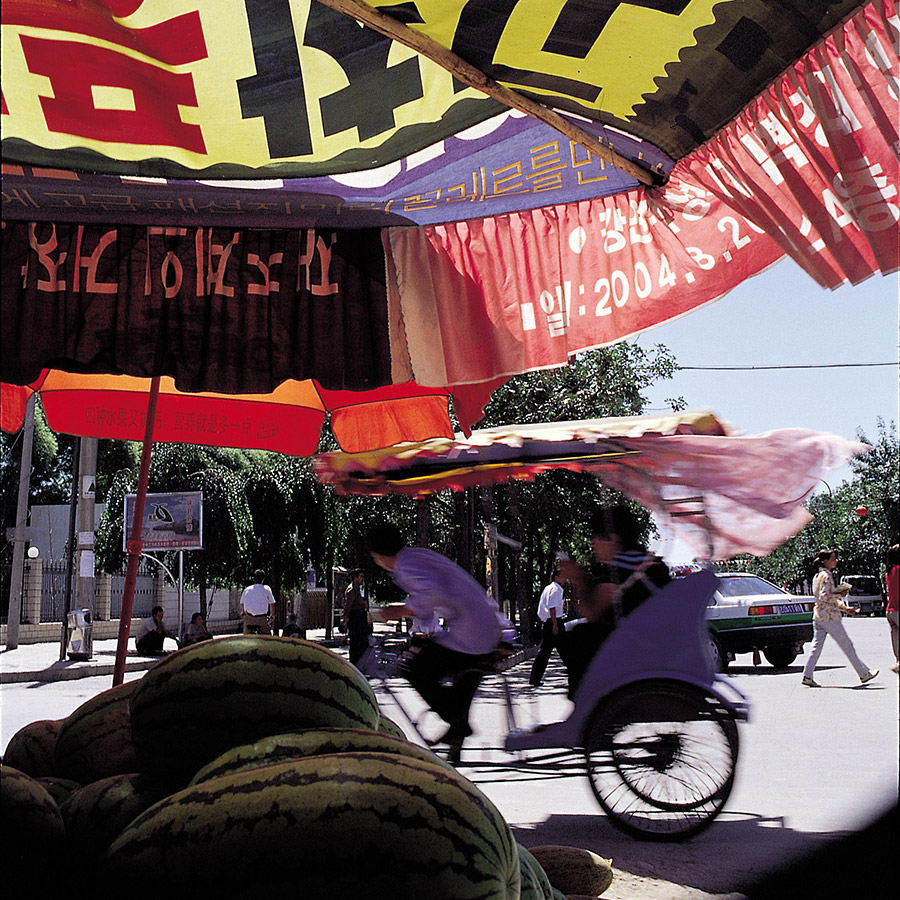
정재철, 〈실크로드 프로젝트 기록〉, 2004, 프린트, 수집한 액자, 가변크기. 아르코미술관 소장품 부분 포함
정재철, 〈실크로드 프로젝트 기록〉, 2004 – 2010(2021년 재구성), 아카이브 재가공, 영상설치
정재철, 〈실크로드 프로젝트 안내문: 영어, 힌두어, 펀잡어, 네팔어, 중국어, 위구루어, 우루두어〉, 2004–2005, 종이에 프린트, 인장, 각 37×25cm
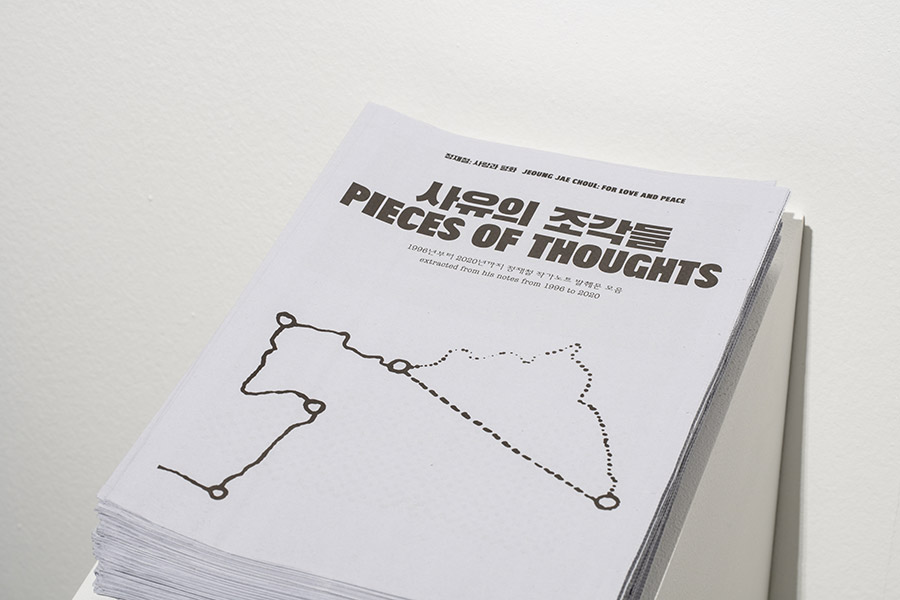
정재철 작가 노트 발췌 모음, 1996-2020. 연구·편집: 이아영
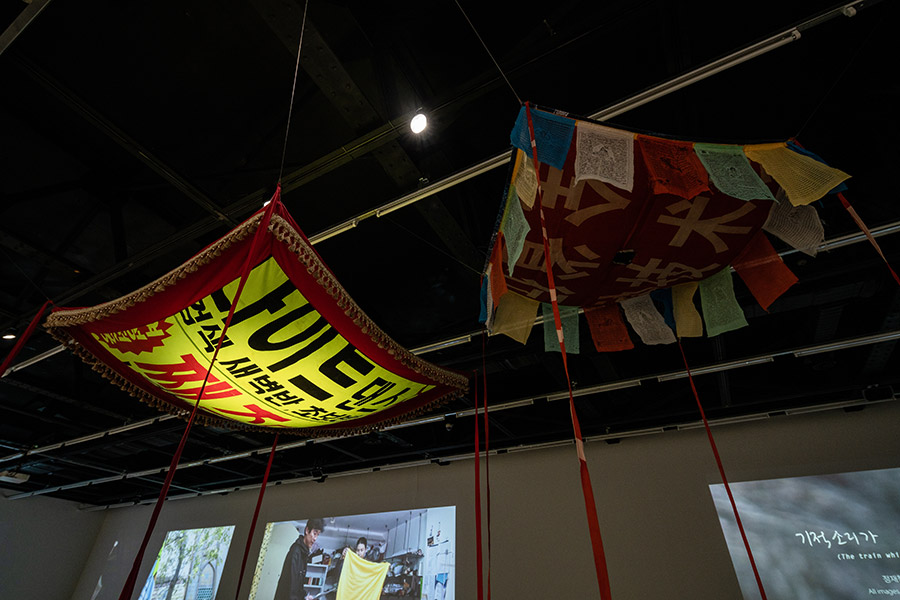
정재철, 〈설치〉, 2008 추정, 폐현수막, 천 등, 190×200cm
정재철, 〈설치〉, 연도미상, 폐현수막, 천 등, 120×120cm
실크로드 프로젝트 현장작업의 생산물은 다양한 기록매체와 오브제로 남겨진다. 전시장에서는 폐현수막을 현지에 배포할 때 동봉한 프로젝트의 안내문, 현장에서 시장, 광장, 골목 등 공공장소에 설치했던 햇빛 가리개, 그리고 이를 설치하고 현지 풍경과 사람들의 모습을 담은 사진기록, 국경을 넘을 때 여권에 찍힌 도장처럼 현지에서 디자인하고 제작한 도장과 도장 화첩을 만나볼 수 있다. 이외에도 종이 지도 위에 경로를 표기한 에스키스는 기성품의 종이지도라는 공간과 작가에 의해 채워진 경로와 정보들이 중첩된다.
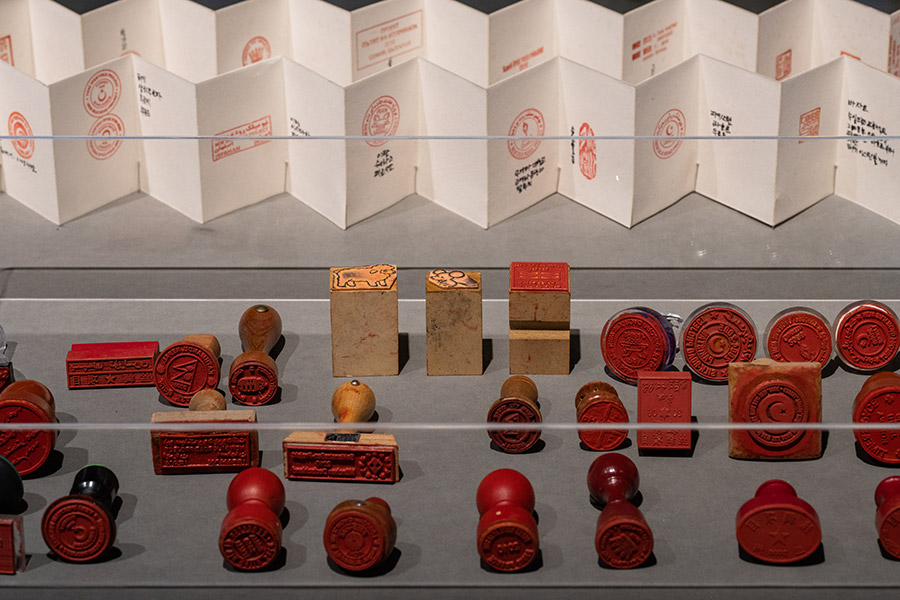
정재철, 〈도장들〉, 2004-2010, 도장, 가변크기
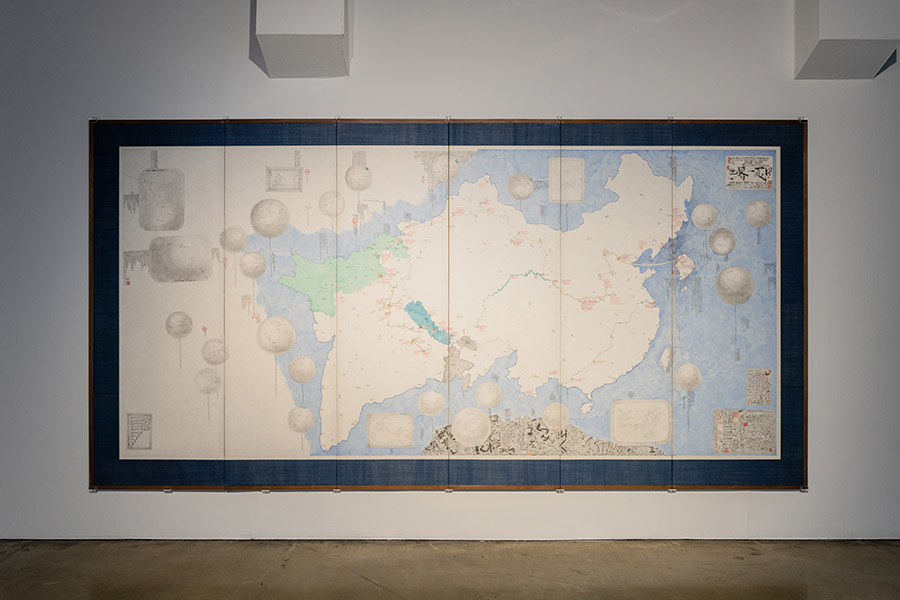
정재철, 〈1차 실크로드 프로젝트 — 루트맵 드로잉 1〉, 2006(2018년 병풍으로 제작), 장지에 연필, 채색, 248×483cm
정재철은 실크로드 프로젝트로 방문한 경로를 다수의 루트맵 드로잉으로 남겼다. 이 루트맵 드로잉은 1차 여정의 종료 이후 경로와 지역을 기록하고, 2차, 3차의 계획을 담았다. 다음 여정의 예견된 장소와 시간의 기록이 그려진 루트맵에는 이미 종료한 이 프로젝트에 시간성을 기입하고 과거의 정재철이 향했던 내일을 마주치게 한다.
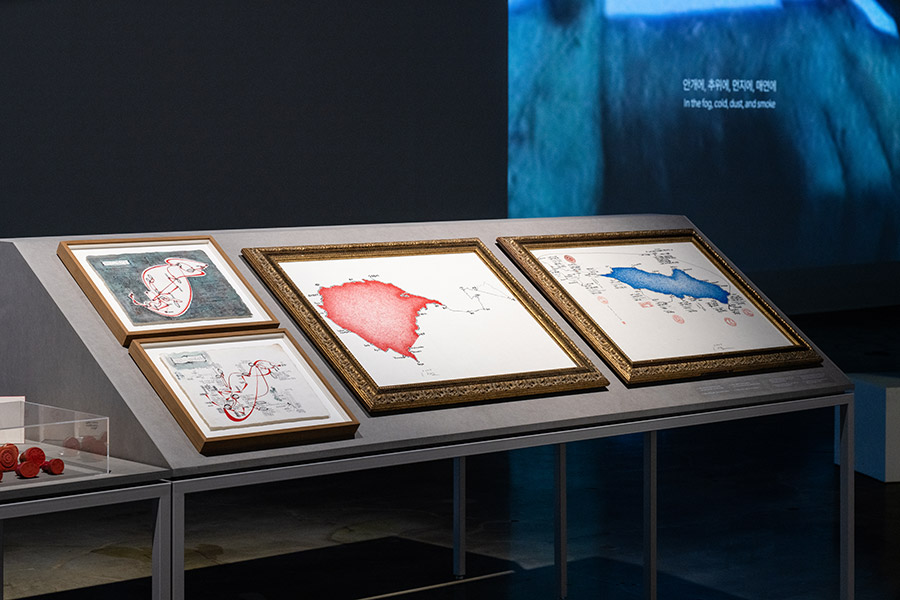
정재철, 〈꽃그늘 키우기·실크로드프로젝트 2006년 12월 – 2007년 2월〉, 2007, 장지에 채색, 25×35cm
정재철, 〈2006년 12 – 2007년 2월 꽃그늘 키우기·실크로드프로젝트 연장〉, 2007, 장지에 채색, 25×35cm
정재철, 〈제목미상〉, 2007–2008, 장지에 채색, 62×82cm
정재철, 〈제목미상〉, 2007, 장지에 채색, 62×82cm
실크로드 프로젝트 1차와 2차 사이에 진행된 <사잇길 작업 — 꽃그늘 키우기>, 2008년 뉴 실크로드 프로젝트의 드로잉은 방문한 지역과 길의 궤적을 담는다. 루트맵 드로잉이 경로의 전체를 지도 위에 촘촘히 담았다면, 이 드로잉의 포물선을 그리며 이동하는 선들은 움직임의 방향을 만들면서 작가의 몸으로 수행하고 관계로 형성한 미시 공간을 그려낸다.
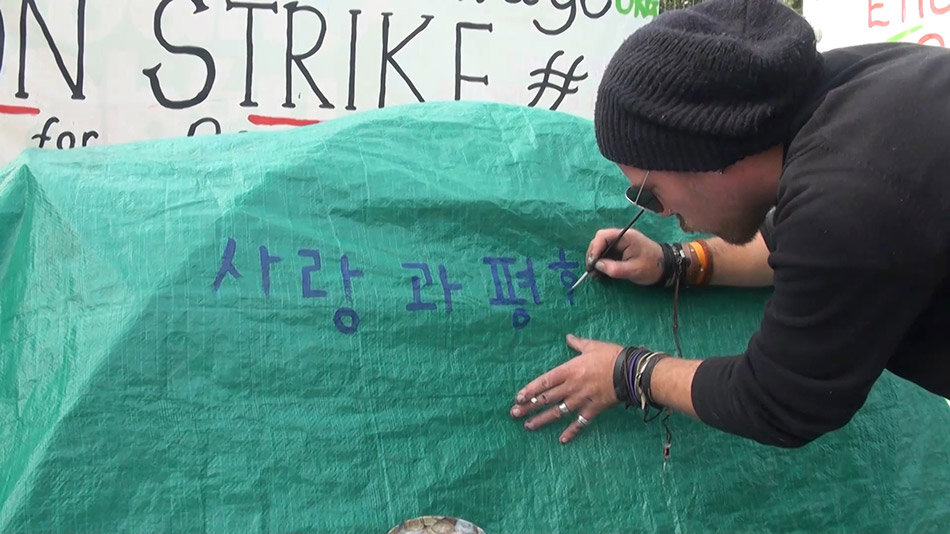
정재철, 〈실크로드 프로젝트〉, 2004–2005, 단채널 비디오, 컬러, 사운드, 1시간 53분 3초
정재철, 〈뉴 실크로드 프로젝트〉, 2008, 단채널 비디오, 컬러, 사운드, 49분 31초
정재철, 〈3차 실크로드 프로젝트〉, 2010, 단채널 비디오, 컬러, 사운드, 33분 43초
실크로드 프로젝트의 1, 2, 3차 여정에 대한 영상 기록물이다. 1차 실크로드 프로젝트의 세탁, 포장, 전달, 재방문을 통한 기록의 과정, 현지인들과 공동으로 제작하고 그늘을 만드는 뉴 실크로드 프로젝트(2차), 3차는 현지의 수공예 장인들의 참여로 점차 자라나는 실크로드 프로젝트의 과정을 담았다. 현수막을 배포하고 현지인들과 상의하면서 새로운 사물을 함께 만들거나 장소에 설치하는 장면들이 기록되어 있다. 공항과 기차역에서 여행 가방을 들고 이동하며 길을 물어 찾고, 현장 작업의 설치를 위해 장소를 탐색하며 이후 다시 길을 떠나는 작가의 모습이 등장한다. 영상은 현지에서 일시적 교류와 교차한 장소들의 현장성을 담아내는 기록물로, 그리고 카메라의 시선이 걷는 호흡대로 흘러가는 르포르타주처럼 보인다.
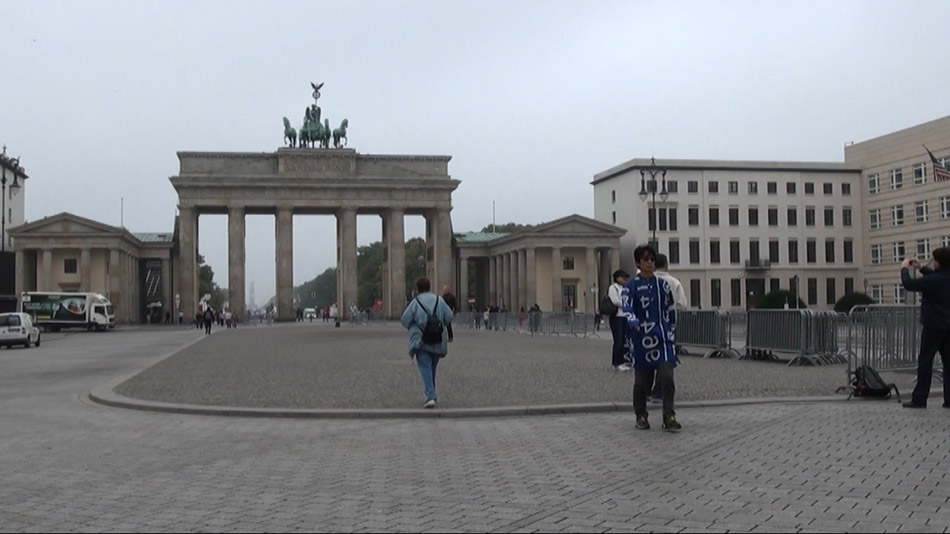
정재철, 〈광장〉, 2010, 단채널 비디오, 컬러, 사운드, 7분 18초
〈광장〉은 실크로드 프로젝트 3차 여정 중 광장 걷기 퍼포먼스를 기록한 영상이다. 작가는 폐현수막으로 제작한 의상을 입고 공항을 출발하여 유럽의 광장을 가로지르는 걷기 퍼포먼스를 실행하였다. 작가노트에는 당시의 퍼포먼스를 “걷기(뛰기), 앉기, 눕기, 남과 같이하기”로 행위의 실천을 기록하고 있다.
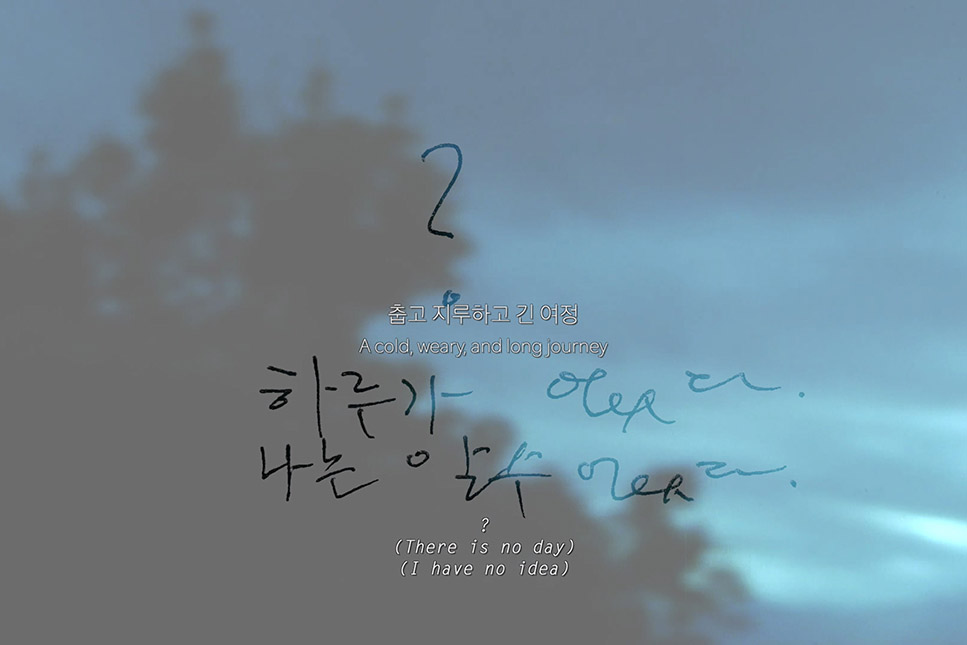
백종관, 〈기적소리가 가깝고 자주 들린다〉, 2021, 단채널 비디오, 컬러, 사운드, 14분
정재철을 바라보는 또 다른 시선은 백종관의 영상에 중첩되어 드러난다. “기적소리가 가깝고 자주 들린다”는 정재철의 작가노트에서 가져온 문장이다. 백종관은 정재철이 생전에 기록한 영상과 글을 살펴보며, 마치 파도에 밀려온 낯선 오브제를 수집하고 재분류하듯 이미지와 텍스트를 이어 붙인다. 영상에서 보여주는 여행과 이주에 대한 감각은 작가의 세계와 궤적을 은유한다. 정재철이 카메라 뒤에서 언젠가 마주할 사건의 기다림이라는 시간, 그리고 이 기다림의 영상을 관찰하는 백종관의 시간이 겹쳐지며 서로 다른 시간과 시선이 연결된다.
〈블루오션 프로젝트〉, 2013–2020
〈블루오션 프로젝트〉는 2013년부터 신안군, 제주도, 영흥도, 독도, 새만금, 백령도 등 동서남북 해안가의 답사를 실행한 현장 리서치 프로젝트이다. 섬에 떠밀려온 수많은 해양 쓰레기들을 보면서 작가는 다른 해안도 그러한지 답사를 떠나 해안가 주변을 기록하고, 쓰레기를 수집했으며, 주민들의 인터뷰와 환경오염의 심각성에 기반한 교육프로그램을 운영했다. 마을, 커뮤니티 기반으로 미술언어로 가능한 실천을 고민하면서 환경 문제를 지속적으로 인지하고 이를 통한 접점을 일으키고자 했다.〈블루오션 프로젝트〉는 국가의 경계, 또는 개별 국가의 규정, 법이 작동하지 않은 인류의 공유지 해양에 주목하고 있다. 해양은 해류의 흐름에 의해 순환하는 환경시스템이다. 작가는 해양의 유동적 특성과 해류를 따라 순환하는 해양쓰레기, 사물의 이동경로를 포착하고, 북한, 중국, 일본 등 인접 국가와 공유하는 바다라는 환경 자원에 질문을 던진다.
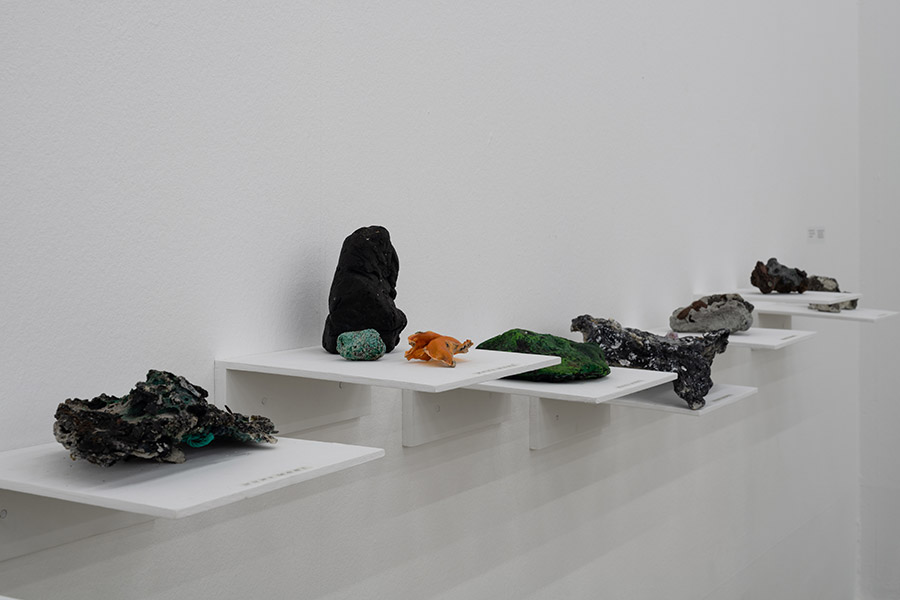
정재철, 〈블루오션 프로젝트-크라켄 부분〉, 2021년 재설치, 혼합재료, 가변크기
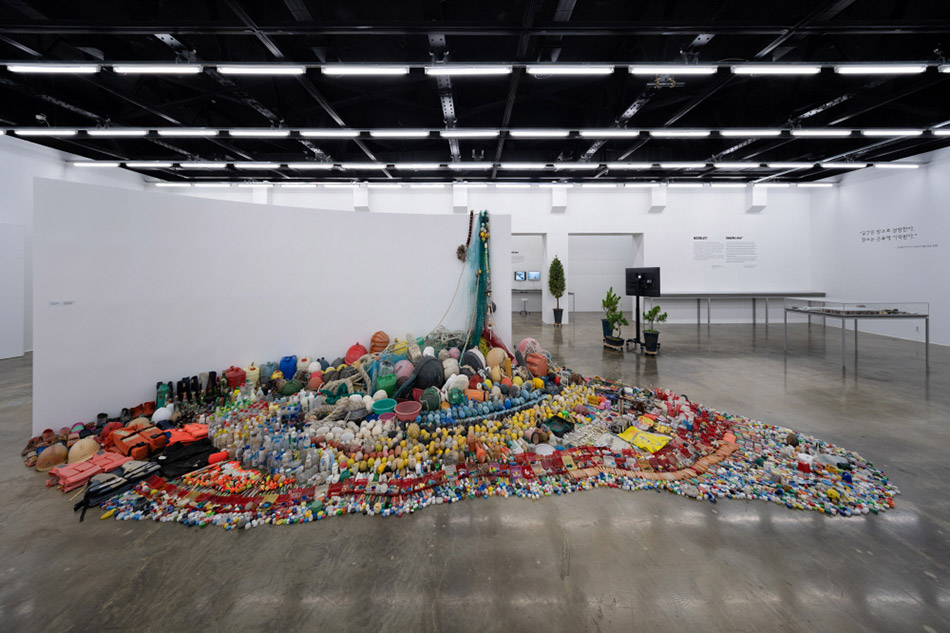
정재철, 〈블루오션 프로젝트-크라켄 부분〉, 2021년 재설치, 혼합재료, 가변크기
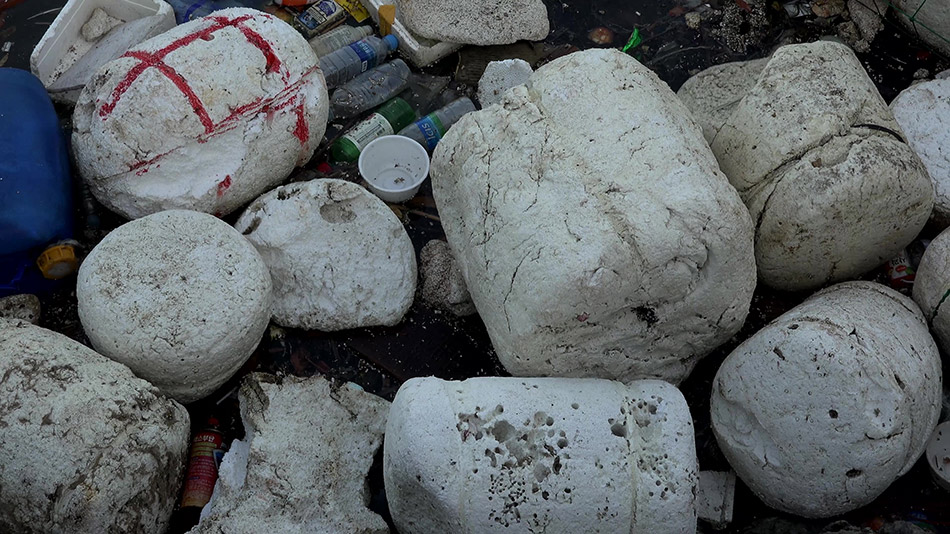
정재철, 〈한여름 1〉, 2018, 단채널 비디오, 컬러, 사운드, 6분 10초
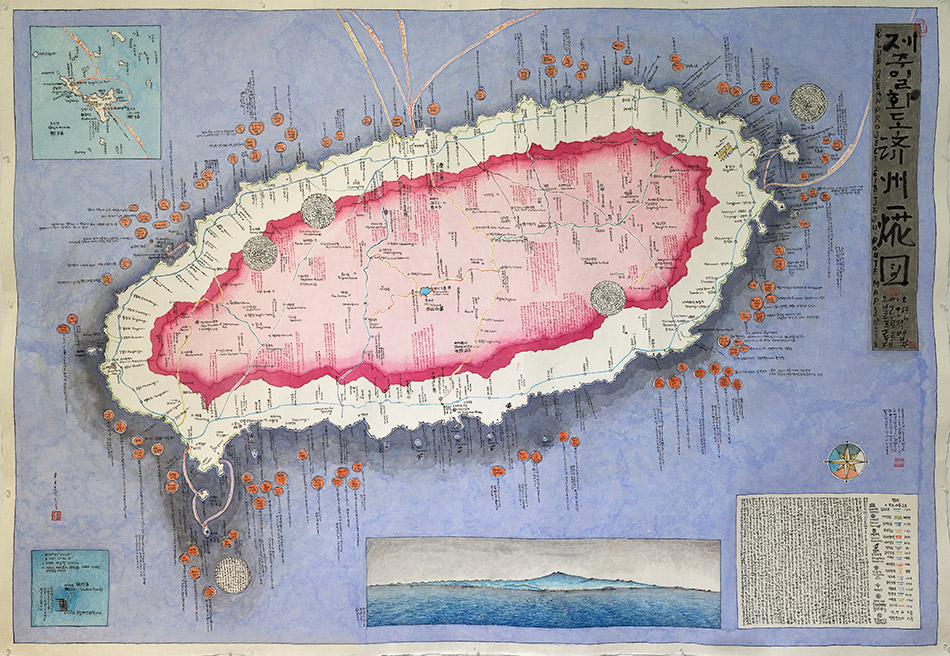
정재철, 〈제주일화도〉, 2019, 장지에 채색, 150×210cm
해양부유사물의 이동을 탐색한 루트맵 드로잉 〈북해남도 해류전도〉, 〈제주일화도〉는 작가의 현장답사, 리서치가 집적되어 지도라는 규범 체계가 아닌 작가가 움직였던 몸짓과 실천 속에서 획득한 데이터를 포함한다. 방위, 범례 등 지도의 요소를 차용하면서 담아낸 해류의 경로 그리고 발견한 해양 쓰레기의 루트맵은 해양산업, 근대화, 문명의 발전과 같은 인류의 역사 뒤에 가려진 마이너스 시대의 모습을 드러낸다. 〈블루오션 프로젝트-크라켄 부분〉을 구성하고 있는 쓰레기와 잔여물은 현재 지구의 환경오염의 근본적인 문제를 지시하는 사물들의 비가시적 네트워크를 보게 한다. 해양쓰레기를 해양부유사물로 명명했던 작가는 한때 상품이었던 것의 표면과 흔적을 프로타쥬 기법으로 그려내 사물들의 출처를 구체화한다(〈프로타쥬 1-16〉). 해류의 흐름에 의해 떠내려온 쓰레기들의 루트맵, 네트워크, 정보 값은 인류세 시기 비서구권의 화석 증거물처럼 제시되는데, 이에 작가 특유의 서정적인 감성이 더해진다.
로컬처럼 살기
이 섹션은 2017년 정재철의 개인전 《분수령》(금산갤러리)에서 선보였던 과천 갈현동 가루개마을에서 채집한 씨앗과 돌, 강원도 양구에서 만든 선사시대 돌도끼 모양의 백자로 구성된다. 분수령(分水嶺)은 산맥을 타고 빗물이 갈라져 흐르는 경계이자 넓게는 지역을 구분하는 경계선을 말한다. 지역과 공동체가 일구어낸 공간과 장소의 흔적, 기억의 층위를 고고학적 방법으로 탐색하는 작가의 행위에는 “로컬처럼 살기”가 환기하는 삶의 태도가 반영되어 있다. 이번 전시에서는 정재철이 과천 가루개마을에서 주민들의 이주가 시작된 후, 버려진 꽃과 나무를 과천 주변에서 수집한 화분에 심거나 가져와서 키워낸 화분의 일부를 선보인다.
전시장에 놓인 화분들은 식물과 보리수나무를 그린 화첩과 연관성이 있다. 그림과 글에는 와병 중 몸과 마음에 대한 이야기가 담긴다. 절임음식인 하몽 만들기 일지에는 느리고 천천히 써 내려간 시간과 온도의 변화에 대한 기록을 엿볼 수 있다.
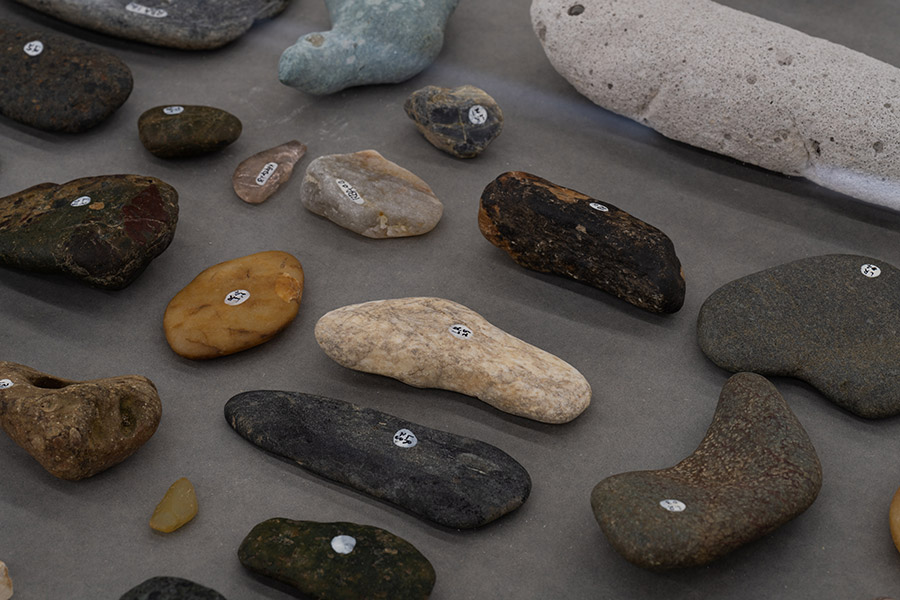
정재철, 〈시간의 씨앗1〉, 2017, 돌, 가변크기
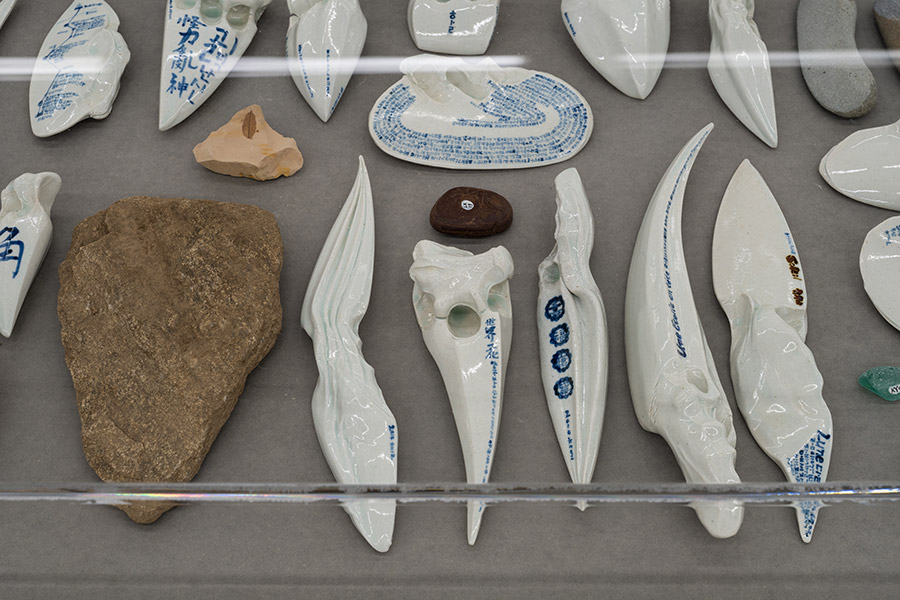
정재철, 〈시간의 씨앗2〉, 백자, 가변크기
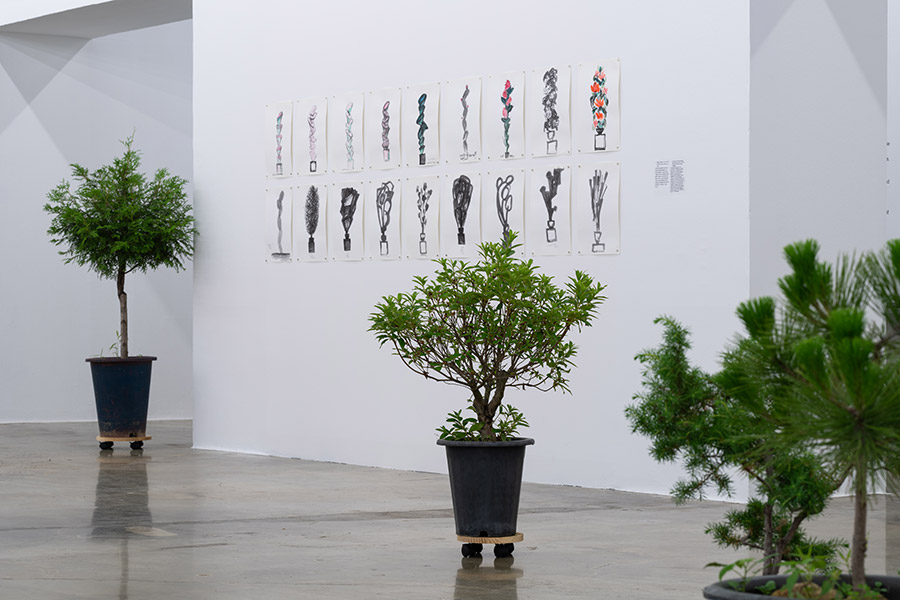
정재철, 〈자라나는 빛〉드로잉, 2018, 종이에 수묵, 채색, 각 39x27cm, 20장
아카이브
아카이브 섹션은 정재철의 작품 세계가 수행적 언어로 전환되기 이전 시기와 조각에서 확장되는 공공성에 대한 성찰을 보여주고자 한다. 정재철은 1980년대 후반에서 2000년 사이 나무재료의 물성을 탐구하는 조각가로 주목받았다. 1990년대 후반 모리셔스 군도의 에스칼레 스튜디오 프로그램, 버몬트 스튜디오(뉴욕), 아트오마이 레지던시(뉴욕) 등 해외 레지던시에 참여하면서 조각매체에서 사물, 오브제, 기록과 같은 조형언어의 확장을 도모하였다. 전시도록, 문서, 작가노트, 사진, 드로잉, 오브제 등이 혼합하여 구성된 섹션에서는 조각에서 출발하여 확장된 조형언어를 살펴보는 동시에 장소와 시간과 관련한 참여적 형식의 공공미술, 커뮤니티 아트와의 접점을 만나볼 수 있다. 이는 조각가로서의 전환점과 확장된 조각, 그리고 공공성에 대한 지향점을 보여줄 것이다.
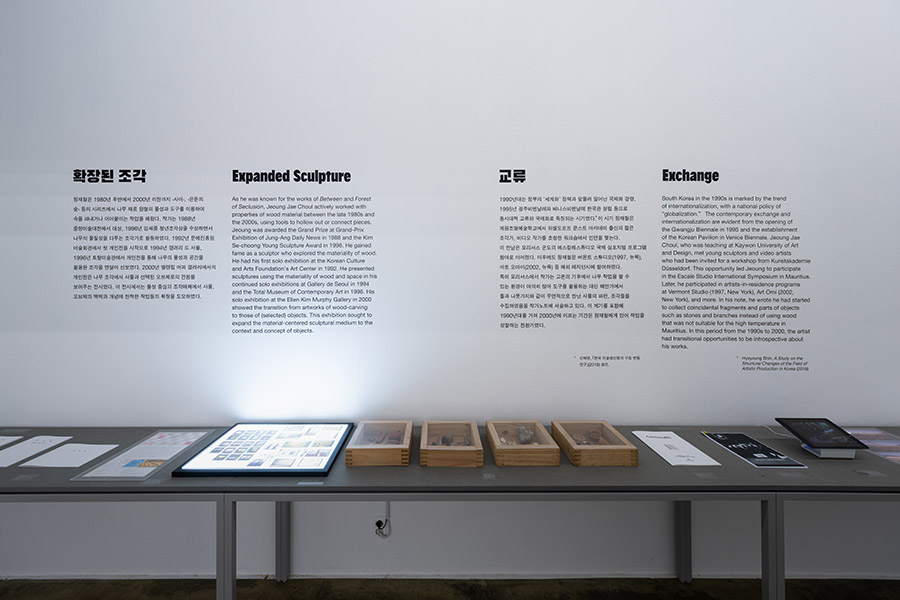
▣ 전시 연계 프로그램
《정재철: 사랑과 평화》 전 연계 프로그램Ⅰ 대담 <미술과 미술 그 바깥의 경계에서>
- 참여자: 노해나(아르코미술관 큐레이터), 임정희(미학, 미술평론), 김종길(경기도미술관 수석큐레이터), 김지연(d/p디렉터), 백종관(영상감독), 이아영(연구자)
- 일시: 7월 31일(토), 오후 1:00-3:00
- 채널: 아르코미술관 유튜브(@ARKO Art Center) 라이브
《정재철: 사랑과 평화》전의 연계 프로그램으로 대담 <미술과 미술 그 바깥의 경계에서>를 마련합니다. 전시의 참여자, 정재철 작가와 교류했던 기획자들과 함께 정재철의 현장 중심 프로젝트와 그 실천에 대해 이야기합니다. 그리고 정재철이 걸어온 길 위에 남겨진 질문은 무엇인지를 살펴봅니다. 이번 대담은 작가를 정의 내리기보다 정재철에 진입할 수 있는 다양한 열쇳말을 만들어보고자 합니다. 대담 참여자들의 여러 시선의 교차를 통해 정재철이 던졌던 질문을 지금 여기에서 마주할 수 있기를 기대합니다.
《정재철: 사랑과 평화》 전시 연계 프로그램Ⅱ 렉처&토크 <우리는 플라스틱에서 벗어날 수 있을까 : <블루오션 프로젝트>와 접속하기>
- 참여자: 김기흥(포스텍 인문사회학부 교수), 양쿠라(시각예술가)
- 일시: 8월 7일(토), 오후 2:00-3:30
- 채널: 아르코미술관 유튜브(@ARKO Art Center) 라이브
《정재철: 사랑과 평화》전의 연계 프로그램으로 <우리는 플라스틱에서 벗어날 수 있을까 : <블루오션 프로젝트>와 접속하기>를 진행합니다. 이 프로그램은 정재철의 <블루오션 프로젝트>(2013-2020)에서 주목하는 지구의 공유지 해양, 그리고 해양부유사물을 매개로 환경사회학의 맥락으로 접근해봅니다. 렉처를 통해 플라스틱이라는 물질에 담긴 문명과 성장의 신화, 그리고 우리는 그 중독에서 탈출할 수 있을지를 질문합니다. 또 해안가에 펼쳐진 플라스틱 역습의 현장을 살펴보고, 전시장에 펼쳐진 <블루오션 프로젝트>의 구체적 물질과 데이터를 보며 대화를 진행합니다. 이를 통해 우리 대지에서 행위하는 요소들을 상상해보고자 합니다.
《정재철: 사랑과 평화》 전시 연계 프로그램Ⅲ 대화 <로컬처럼 살기>
- 참여자: 김월식(작가, 무늬만커뮤니티), 신지승(영화감독, 끄트머리국제마을영화제), 임지연(미학연구자, 생태네트워크 조율), 윤상훈(녹색연합 전문위원, 생태네트워크 조율)
- 일시: 8월 19일(목), 오후 6:00-8:00
- 채널: 줌 웨비나
*이 프로그램은 사전 신청을 통해 진행됩니다. 프로그램 신청은 홈페이지, SNS를 통해 확인바랍니다.
《정재철: 사랑과 평화》전의 연계 프로그램으로 <로컬처럼 살기>를 진행합니다. 이번 전시에서는 정재철이 공동체, 지역민과의 관계를 형성하고 이루었던 지점에 주목하는 ‘로컬처럼 살기’의 섹션을 마련했습니다. 이번 토크 프로그램은 이러한 실천과 태도에 대해 고민하고자 마련하였습니다. 지역을 중심으로 활동하는 예술가, 영화감독, 활동가를 초청하여 일상 속 실천을 통해 공동체, 로컬에 가까이 자리하며 살아가기에 대해 들어봅니다.
*상기 일정 및 패널은 변동될 수 있습니다.
▣ 전시전경
제1전시실
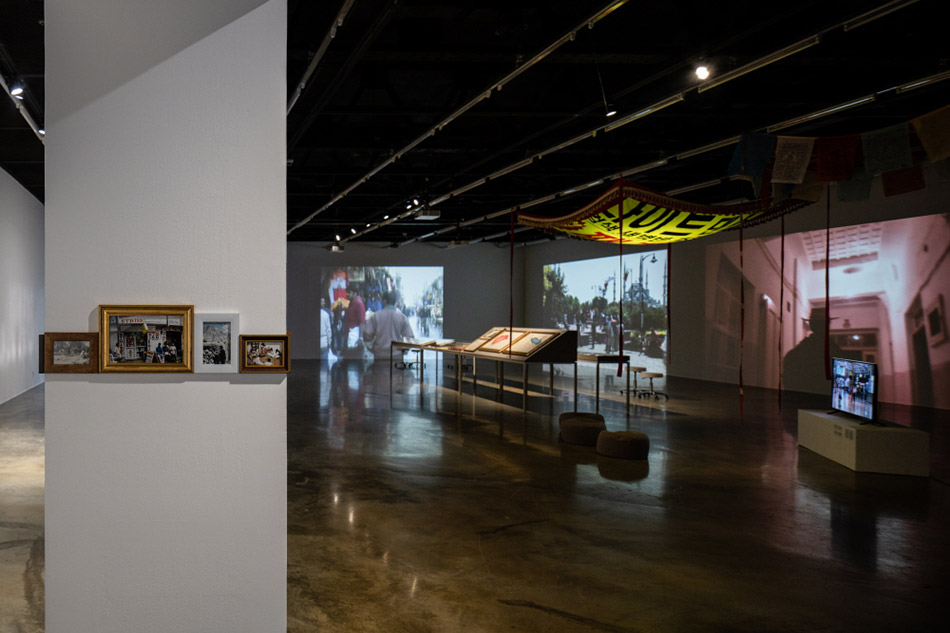
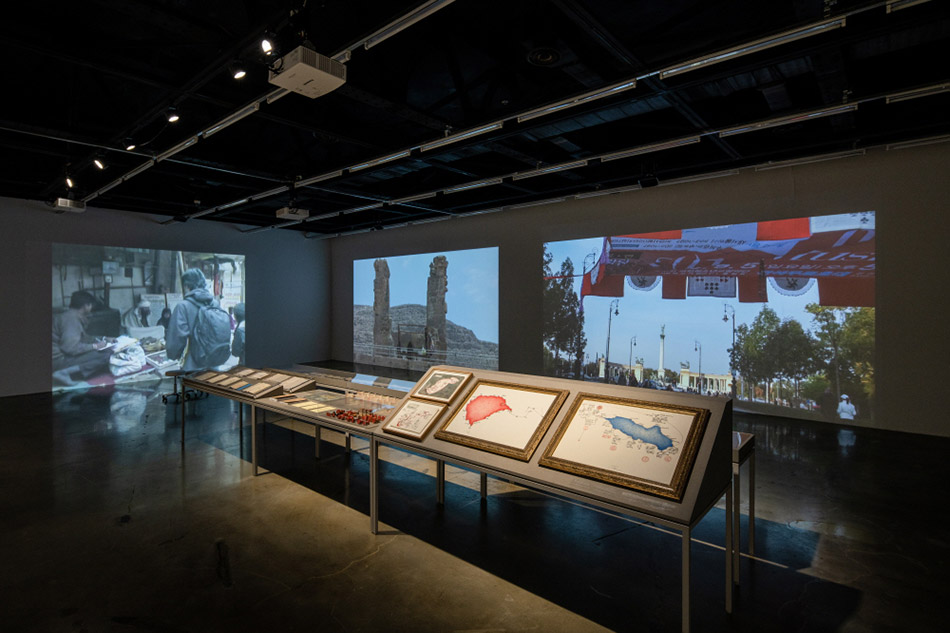
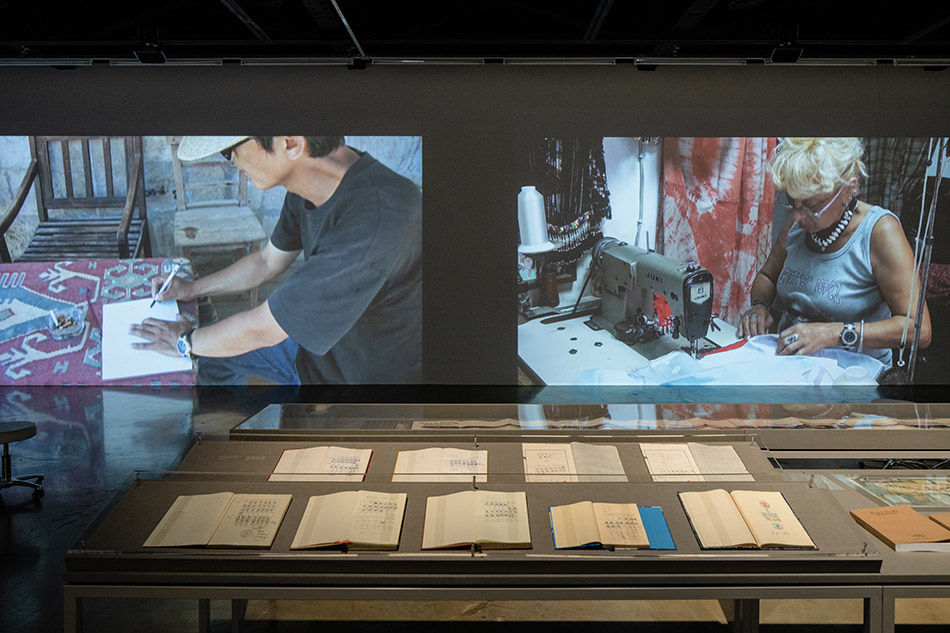
제1전시실 전시전경. 사진: 홍철기
제2전시실
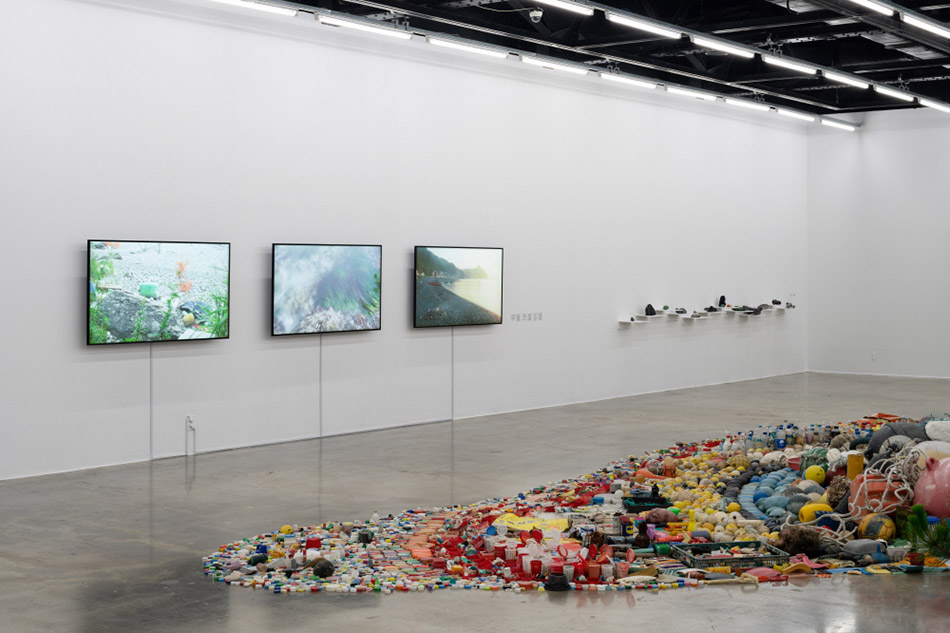
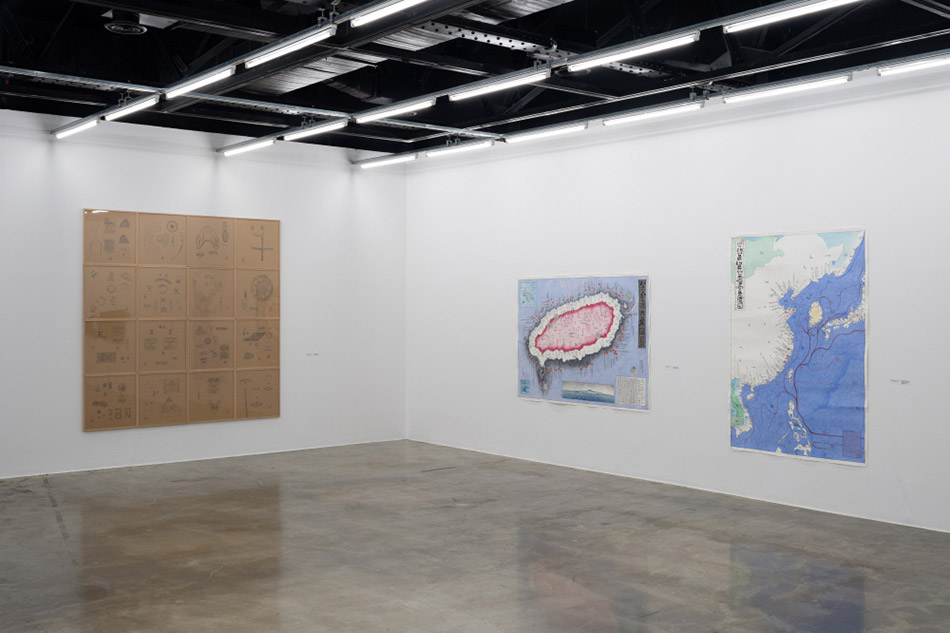
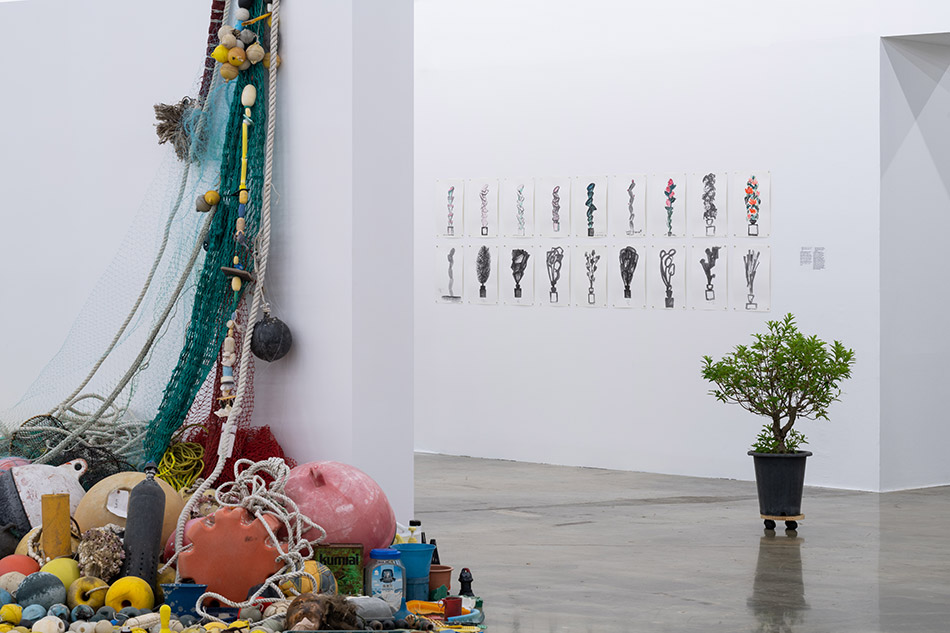
제2전시실 전시전경. 사진: 홍철기
▣ 작가 소개
정재철(1959 – 2020, 순천)은 1980년대 후반에서 2000년까지 〈사이〉, 〈은둔의 숲〉 시리즈 등 조각 매체를 중심으로 활동하였다. 1992년 문예진흥원 미술회관에서 첫 개인전을 열었으며, 2005년 이후 문화 전이와 이동을 주제로 실크로드 길을 따라 실행한 〈실크로드 프로젝트〉(2004 – 2011)의 현장 작업을 진행하였다. 이와 관련해 프로젝트 스페이스 집, 금산갤러리, 김종영미술관 등에서 다수의 개인전을 열었다. 이후 국내 해안가를 탐사하며 해양오염에 대한 문제의식을 기반으로 〈블루오션 프로젝트〉(2013 – 2020)의 현장 답사를 진행하고 개인전 《간석지대》(JM갤러리, 2015)를 개최했다. 단체전 《우리는 모두 집을 떠난다》 (경기도미술관, 가오슝미술관, 2019), 《2019 국제생태미술전 — 오션 뉴메신저스》(제주현대미술관, 2019), 《#예술#공유지#백남준》(백남준아트센터, 2018) 등에 참여한 바 있다. 이외에도 장소 특정적 설치 및 공공미술로 참여한 제주비엔날레 2017 《투어리즘》(제주도립미술관, 2017), 《지리산 프로젝트 2014》 (실상사, 2014), 2006 부산비엔날레 《어디서나》 (온천천, 부산, 2006) 등이 있다.
▣ 참여자 소개
백종관
백종관(1982)은 리서치를 기반으로 기록과 이미지, 사운드를 수집하여 역사적 관계 안에서 매체 실험을 시도한다. 수집한 영상과 사운드를 재편집하고 뒤섞는 몽타주를 통해 영화와 이미지의 역사를 교차시키며 오늘날의 무빙이미지의 위상에 질문을 던진다. 〈추방자들〉, 〈순환하는 밤〉, 〈이빨, 다리, 깃발, 폭탄〉 등의 작품을 제작하였고, 《디어시네마》(국립현대미술관, 2018), 《파리/베를린 국제예술제》(2018), 《함부르크 국제단편영화제》(2018), 《도쿄 이미지포럼》(2018), 《전주국제영화제》(2016, 감독상) 등 국내외 다수의 영화제와 전시를 통해 작품을 발표했다. 이외에도 무용, 연극, 건축 등 다양한 분야에서 협업을 이어오고 있다.
이아영
이아영(1979)은 동아시아 현대미술사 쓰기의 가능성에 대한 관심을 둔 연구자로 전후 동아시아 아방가르드 퍼포먼스 아트를 연계 조망하는 연구 및 아카이브 전시 실천에 주목한다. 문화정보원 〈아시아의 퍼포먼스 아트〉(국립아시아문화전당, 2015) 기획 및 공동기획으로 《Rehearsals from the Korean Avant-Garde Performance Archive》(주영한국문화원, 2017), 《이미지 인류학, 므네모시네 아틀라스》(보안여관, 2020) 등이 있으며, 2019년 한국-폴란드 퍼포먼스 아트 교류 프로젝트인 〈Something in Common〉 심포지엄에서 한국아방가르드 퍼포먼스와 관련된 논고를 발표하였다.
자료담당자[기준일(2021.6.28)] : 아르코미술관 노해나 02-760-4607
게시기간 : 21.6.28 ~
Jeoung Jae Choul: For Love and Peace

Reservation : https://booking.naver.com/booking/12/bizes/544990
- Date : July 1 — August 29, 2021
*Due to COVID19, The Schedule might be changed. Please Check ARKO Art Center website before visiting. - Location : ARKO Art Center Galley 1, 2
- Admission : Free
- Artist : Jeoung Jae Choul (1959-2020)
- Participants : Film Commissioned by Jongkwan Paik, Artist’s Notes Reseached and Edited by Ahyoung Lee
- Host : Arts Council Korea
- Opening Hours: Tues–Sun, 11am–7pm
*Please find out online documentation film via YouTube instead of Docent Programme.
▣ Introduction
The Jeoung Jae Choul: For Love and Peace exhibition presents a retrospective show on artist Jeoung Jae Choul (1959 – 2020) in celebration of his one-year memorial. It outlines his participatory projects, all of which were held in many different places through the utilization of mobility. It reconstructs his on-site actions—which formed his ‘documented and collected’ artworks—and it attempts to follow his artistic practices.
Jeoung was awarded the Grand Prize at Grand-Prix Exhibition of Jung-Ang Daily News in 1988. It was in this time that he began to make his mark as a sculptor. In 1995, he participated in an international residency via an academic exchange workshop with Kunstakademie Düsseldorf through the university where he’d given a lecture. Motivated by the globalization that the Korean art scene was undergoing, he explored a conceptual and performative visual art language through traveling and migration beginning in the 2000s. This exhibition marks his post-2000s turning point, in terms of both his attitude and his methodology as an artist. Through his introduction of site-focused works such as Silk Road Project (2004–2011) and Blue Ocean Project (2013–2020), he revealed a transformation of his outlook and thoughts as well as his introspection towards societal issues.
At the Gallery 1, Silk Road Project (2004–2011) is recontextualized based on documentation such as photography, films, route maps, and travel diaries. For Jeoung, traveling, migrating, and leaving were seen as artistic practices as well as ways of living life. The project enabled him to cross the border of countries, and the used banners that he gave to people created shadows under the burning sun. With this, he created and documented coincidental encounters, exchanges, incidents, and happenings. Traveling became a practice, and migration and movement became a postcard unexpected to be delayed or returned. As he departed one place, the loss of place occurred; thus, documentation and collection of the sites were inevitable for him. As the documentation and collection processes were repeated, they became varied and finally came about through the factual and edited documentation. Such a gap in his work served as a remainder, fragment, and trace of direct contact from that particular place. At the Gallery 1, that sense of absence left in his documentation is present. In the current time — where we are restricted in the movement of travel — the Silk Road Project and the scenes of sites and migration remind us that a sentiment of absence exists. This sentiment fills the distance between long ago, the present, and the past. The movement of migration that appeared in the Silk Road Project connects to the next video work by Jongkwan Paik that links pieces of the erased calendars from Jeoung’s notes, his correspondences, postcards from the past, and documentation of the artist.
The Gallery 2 presents Jeoung’s perspective on a cyclic value and vitality found in an object’s physicality. His point of view towards an object shows his formative interest in sculptures, his perception of strength and vitality inherent in objects themselves, and his thoughts on ecology. The Blue Ocean Project (2013–2020) deals with the migration of waste in combination with ocean currents. It captures ocean pollution — the common land of humankind — as physical evidence and shows the network between non-human things that interfere with humanity and accelerate incidents. The burnt plastic, entangled rock surface, and floating waste from neighboring countries through ocean currents are collected, and Jeoung coins the term of ‘floating objects’ to these items. Jeoung’s interpretation serves to recognize non-human things as interfering actors on a global level, specifically within an ecological network. It also reflects a perception regarding the common land that is linked beyond borders. The Silk Road Project directs towards the outside of the subject, as it practices encountering and exchanging. The respect toward the cycle of non-human things and strength of coexistence portrayed in Blue Ocean Project directs towards the common good that works beyond the borders of the common land.
The title For Love and Peace is a written phrase on a tent at the anti-war protest camp in Parliament Square, London. This was the last traveling destination of the Silk Road Project. Love and peace—the two words often found in Jeoung’s works —reveal the horizon of the commons that he aimed to reflect through his participatory projects. The Jeoung Jae Choul: For Love and Peace exhibition follows the attitudes echoed in his performative and bodily practice of migrating between borders, as well as his thoughts on ecology shown in cyclic objects based on his awareness of problems on the common land of humankind. With an increasing sense of planetary crisis on the common land and a new state of globalization, we face the emergence of a new boundary occupied by hostility, hatred, and conservative politics. In this “globalization-minus,” as Bruno Latour said—which encompasses the loss of solidarity and environmental destruction—Jeoung’s practices and thoughts suggest the direction we should face in times of new emerging boundaries and standards.
▣ Featured Works
Silk Road Project, 2004–2011
The Silk Road Project encompasses three phases, all taking place from 2004 to 2011. The first project was a process of simple delivery and confirmation of usage. This delivery started in Seoul and extended to 22 points in China, Pakistan, India, and Nepal. Those points became signs of each location through the setting up of a road of banners. Following this, the villages began to expand voluntarily. With local language translation, the artist delivered discarded banners and revisited the locations to confirm the banners’ usage and perform documentation and recollection. The Flowering Line project—a participatory project for creating shadow and rest areas with the discarded banners—was ongoing after the first project in China, Tibet, Vietnam, Cambodia, and other locations. In 2008, the second project began as the New Silk Road Project. It expanded with a concept of a bazaar in which the project became a site of dealing and exchanging held in 13 locations; this included Pakistan, Iran, and Turkey. The third project in 2010 ended in Turkey and Greece, and it made its way to Europe to complete its conclusion in London. Under the subtitle Plaza, the journey continued by making sunshades in each city to install them in the next cities, along with the making of stamps and the plaza-walking performance.

Jeoung Jae Choul, Silk Road Project Documentation, 2004, Print, collected frames, Dimensions variable. including part of the ARKO Art Center Collection Jeoung Jae Choul’s Notes, 1996–2020. Researched and edited by Ahyoung Lee
Jeoung Jae Choul, Installation, ca. 2008, discarded banners, cloths, 190×200cm
Jeoung Jae Choul, Installation, undated, discarded banners, cloths, 120×120cm
The outcome of the Silk Road Project on sites was left as various documentations and objects. These included: (1) the Instructions about the project written in local languages when distributing discarded banners, (2) the sunshades made of discarded banners and their installation in public places such as markets, plazas, and allies, (3) the photo documentation of installation, landscapes, and people, and (4) locally-designed stamps such as those on passports and handscrolls. Additionally, the rough sketches marking locations on the paper map overlap the spaces on the ready-made map with the routes and information deleted and filled by the artist.

Jeoung Jae Choul, Stamps, 2004–2010, Stamp, Dimensions variable

Jeoung Jae Choul, 1st Silk Road Project — Route Map Drawing 1, 2006 (made as a folding screen in 2018), Pencil, color on sliding-screen paper, 248x483cm
The artist left many route map drawings of the places he visited during the Silk Road Project. This drawing marks routes and locations from the first visit as well as future plans for the second and third visits. This map — which predicts the next place and time — adds temporality to this already-ended project and puts us into the perspective of encountering the ‘tomorrow’ that the artist from the past faced.
Jeoung Jae Choul, Flowering Line, Silk Road Project, December 2006–February 2007, 2007, Color on sliding-screen paper, 25×35cm
Jeoung Jae Choul, Flowering Line, extended from the Silk Road Project, December 2006–February 2007, 2007, Color on sliding-screen paper, 25×35cm
Jeoung Jae Choul, title unknown, 2007–2008, Color on sliding-screen paper, 62×82cm
Jeoung Jae Choul, title unknown, 2007, Color on sliding-screen paper, 62×82cm
The In-between Path Project: Flowering Line — which happened between the first and second Silk Road Project — deals with the locations and traces that the artist visited during the New Silk Road Project in 2008. The route map drawing includes in great detail the entire journey on the map. These moving arc lines of the drawing produce the direction of the movement to create a microscopic space that the artist performed and formed through relationships with his body.

Jeoung Jae Choul, Silk Road Project, 2004–2005, Single-channel video, color, sound, 1h 53’3”
Jeoung Jae Choul, New Silk Road Project, 2008, Single-channel video, color, sound, 49’31”
Jeoung Jae Choul, 3rd Silk Road Project, 2010, Single-channel video, color, sound, 33’43”
These are the video documentations of the first, second, and third journey of the Silk Road Project. The documentation of the first project encompassed the cleaning, wrapping, delivering, and revisiting processes. The New Silk Road Project, the second journey, involved co-producing and co-creating sun shadows with local residents. The third journey elaborated on how this project grew through collaboration with the local handmade artisans. The videos also document how Jeoung distributed banners and discussed the creation and installation of new objects with local residents. He is also captured asking for directions — backpack on his shoulders as he moved from an airport to a train station — as well as finding installation locations and uninstalling to depart yet again. The videos function as documentation of sites and cross-sectional places where he made a temporary exchange. They take a form of a reportage in which the camera follows the artist in both body and breath.

Jeoung Jae Choul, Plaza, 2010, Single-channel video, color, sound, 7’18”
Plaza is a walking performance documentation video during the third Silk Road Project. Jeoung wore clothes made of discarded banners and departed an airport to crosswalk plazas in Europe as a performance. He wrote this act in his note, “Walking (Running), sitting, lying, and doing together.”

Jongkwan Paik, A Train Whistle is Near and Often Heard, 2021, Single channel video, color, sound, 14’
Another perspective toward Jeoung is overlayed in Jongkwan Paik’s video. The title, A Train Whistle is Near and Often Heard, comes directly from the artist’s notes. Paik went through old moving images and texts by Jeoung. He added up images and texts and collected and recategorized them as though they were unfamiliar objects washed up by the waves. The sensation surrounding traveling and migrating in the video metaphorically describes Jeoung’s world and traces. In this, the time of waiting that Jeoung experienced behind the camera, and the time of Paik — who observes the video of that waiting — overlap with each other, creating an encounter of time and a perspective of difference.
Blue Ocean Project, 2013–2020
The Blue Ocean Project is a site research project encompassing visits made to Sinan-gun, Jeju-do, Youngheung-do, Dok-do, Saemangum, Baekryung-do, and other various beaches in South Korea. He observed marine garbage that had washed up onto the island shores, visited places to record around the beaches, collected garbage, interviewed local residents, and ran an educational program about environmental pollution. Based on villages and communities, he tried to find a possible practice in visual art language, being aware of and creating a project about pollution.
This section focuses on what Jeoung was interested in, such as the boundary of nations, individual regulations of nations, and the common ocean owned by humanity where the law does not apply through the Blue Ocean Project. The ocean is an environmental system that circulates by the flow of ocean currents. Jeoung documented and captured the route of marine garbage and objects that circulated by the fluid nature of the ocean and its currents, and he questioned the environmental resources of the ocean shared with neighboring nations such as North Korea, China, and Japan.

Jeoung Jae Choul, Blue Ocean Project — Part of Kraken, reinstalled in 2021, Mixed media, Dimensions variable

Jeoung Jae Choul, Summer 1, 2018, Single-channel video, color, sound, 6’10”

Jeoung Jae Choul, Stories of Jeju, 2019, Color on sliding-screen paper, 150×210cm
Two works, Current Diagram of South Island and North Sea and Stories of Jeju do not just follow a normative system of a map; rather, they are the route map drawings made from observing marine floating objects and their movement. They also incorporated an accumulation of the artist’s on-site visits and research, including data collected by the artist’s movement and practice. The route map that borrows a language of maps — such as cardinal points and a legend — captures the route of ocean currents and discovered marine garbage. It reveals the era of minus behind human progress, such as the ocean industry, industrialization, and the progress of civilization. The Blue Ocean Project — Part of Kraken consists of concealed garbage and residual trash, and it visualizes the invisible network among the objects that indicate the fundamental problems of environmental pollution. Jeoung named marine garbage as marine floating objects, giving shape to their origins as objects that were once commodities and portraying their surface and traces in a frottage technique (Frottage 1-16). The route map of garbage that had floated through the ocean current, network, and information value are presented as the specified fossil evidence in the non-Western world in the Anthropocene. It portrays these items lyrically, uniquely, and artistically.
Living Like a Local
This section consists of seeds and stones collected in the Garuge village of Galhyun-dong, Gwacheon, and stone-axe-shaped white porcelains made in Yanggu, Kangwon-do; these were shown at Watershed, Jeoung’s solo exhibition at Keumsan Gallery in 2017. A watershed is a border between boundaries or regions made by rain alongside the mountains. Jeoung archaeologically explored the traces of spaces and locations cultivated by locals and communities, as well as the layers of memories that reected his attitude that one should live life by “living like a local.” This exhibition shows parts of flower pots that the artist collected near Gwacheon or re-planted, all of which were abandoned after residents had moved away.
These displayed pots are highly related to his handscroll of drawing plants and Bodhi trees. The drawing and text contain his story about mind and body lying in a sickbed. His diary of Jamon-making shows the transformation of time and temperature that he gradually wrote little-by-little.

Jeoung Jae Choul, Seeds of Time 1, 2017, Stone, Dimensions variable

Jeoung Jae Choul, Seed of Time 2, 2017, White Porcelain, Dimensions variable

Jeoung Jae Choul, Growing Light, drawing, 2018, color ink on paper, 39x27cm each, 20 pieces
Archive
The archive section shows Jeoung’s pre-period of performative language and his idea of the public expanded from the sculpture. He gained fame as a sculptor who explored the materiality of wood between the late 1980s to the 2000s. In the late 1990s, he participated in the Escale Studio Program in Mauritius, Vermont Studio in New York, Art Omi in New York, and more. He explored the expanded formative language such as objects and documentations. This section consists of exhibition catalogs, documents, artist’s notes, photography, drawings, and objects, and it seeks to study the expanded formative language that began from his sculptures. In addition, it presents how participatory public art is encountered in relation to time, space, and community art. It shows his turning point as a sculptor, the idea of expanded sculpture, and an orientation towards a concept of the public.
▣ About the Artist
Jeoung Jae Choul
Jeoung Jae Choul (1959 – 2020, Suncheon) actively worked with sculpting media from the late 1990s to 2000. He was known for the works of Between and Forest of Seclusion. He had his _rst solo exhibition at the Korean Culture and Arts Foundation’s Art Center in 1992. From 2005, he presented and exhibited the Silk Road Project (2004 – 2011) that focused on a theme of cultural transfer and migration, of which was realized along traveling the silk road. This project was presented as several solo exhibitions at Project Space Zip, Keumsan Gallery, Kim Chong Yung Museum, and others. Later, he started Blue Ocean Project (2013 – 2020) on a theme of ocean pollution as he researched beaches in South Korea. It was shown at his solo exhibition, Tideland (JM Gallery, 2015), and group exhibitions such as Moving & Migration (Gyeonggi Museum of Modern Art, Kaohsiung Museum of Fine Arts, 2019), Ocean_New Messengers (Jeju Museum of Contemporary Art, 2019), and #Art #Commons #NamJunePaik (NJP Art Center, 2018). He also presented both site-speci_c works and public artworks at Jeju Biennale (Jeju Museum Of Art, 2017), Jirisan Project 2014 (Silsang Temple, 2014), and Busan Biennale (Oncheon-cheon, Busan, 2006).
▣ About the Participants
Jongkwan Paik
Jongkwan Paik (b.1982) collects documentation, images, and sounds and has experimented with media within historical relationships based on research. Through a montage of re-editing and mixing collected moving images and sound, he intervenes in the history of _lms and images to question the status of today’s moving image. He is known for works such as Deportees, Cyclicla Night, and Frequency Resonance, and his works were presented at Dear Cinema (National Museum of Modern and Contemporary Art, 2018), Rencontres Internationales Paris/Berlin (2018), Hamburg International Short Film Festival (2018), Tokyo Image Forum (2018), Jeonju International Film Festival (Best Director Prize, 2016), and numerous other international and domestic _lm festivals and exhibitions. He also collaborates with artists in other genres such as dance, theater, and architecture.
Ahyoung Lee
Ahyoung Lee (b.1979) is a researcher whose interest lies in writing and _nding possibilities in contemporary art history in East Asia. She focuses on research and archive exhibitions on avant-garde performances in post-war East Asia. She curated Performance Art in Asia at ACC Archive and Research (Asia Culture Center, 2015), co-curated Rehearsals from the Korean Avant-Garde Performance Archive (Korean Cultural Centre UK, 2017), and Image Anthropology, Mnemosyne Atlas (Boan Stay, 2020). She also keynoted the Korean avant-garde performance at Something in Common, a symposium on Korean-Polish performance art exchange in 2019.
자료담당자[기준일(2021.6.28)] : 아르코미술관 노해나 02-760-4607
게시기간 : 21.6.28 ~
